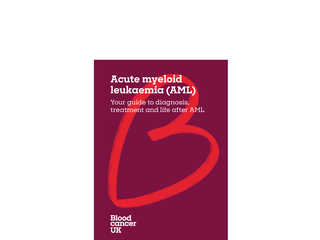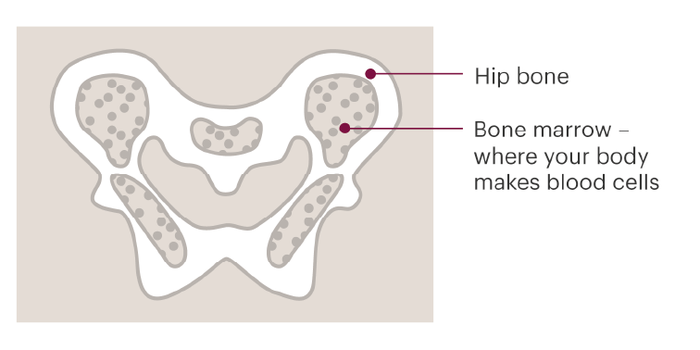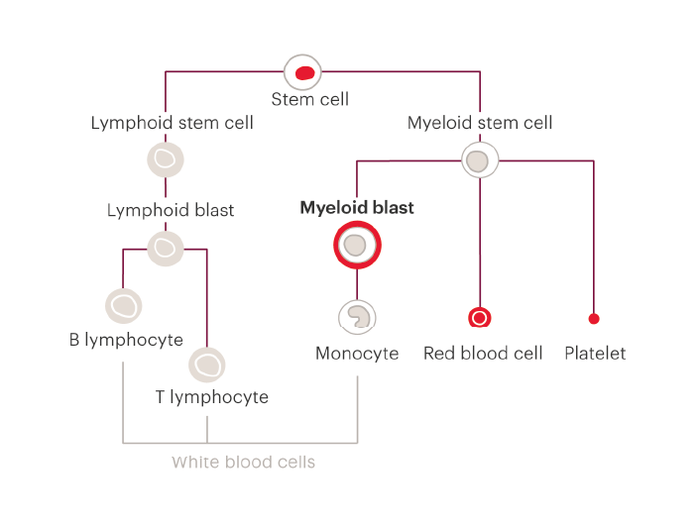What is acute myeloid leukaemia (AML)?
Acute myeloid leukaemia is a type of blood cancer.
It’s called ‘acute’ because it develops very quickly and often needs urgent treatment.
Normally, your body creates millions of new blood cells every second. AML happens when something goes wrong with this process.
On this page:
What is AML?
In AML, certain types of blood cells don’t grow properly. This stops your blood doing the things it normally does to keep you healthy, like fighting off infections or carrying oxygen around the body.
These faulty blood cells (leukaemia cells) can quickly build up in your body. The more these leukaemia cells build up, the less room there is for normal blood cells to grow. This causes the symptoms of AML.
Fast treatment is often needed to reduce the number of leukaemia cells.
Who gets AML?
About 3,100 people are diagnosed with AML each year in the UK. Three quarters of these (75%) are aged 60 or over, but AML can happen at any age. We have more information about causes of AML.
These web pages are about AML in adults. We have separate information about AML in children.
"In hospital, everyone around me was a lot older. I felt so different and like I didn't fit in."
Bav was diagnosed with AML as a teenager.
Read Bav's story about having blood cancer as a young person.

Types of AML
There are different subtypes of AML, depending on which genetic changes (mutations) the AML cells have, which types of blood cells are affected, and whether your AML has been caused by previous cancer treatment or developed from a previous blood condition. We explain this more in our information about prognosis and risk groups.
AML almost always affects white blood cells, which are part of your immune system. In very rare cases, it's the red blood cells or platelets that are faulty. These are very rare types of AML called acute erythroid leukaemia and acute megakaryoblastic leukaemia. The treatments for these types of AML are the same and the information on our website relates to all types of AML.
A small number of people with AML have a subtype called APL (acute promyelocytic leukaemia). This has quite different treatments. We have separate information about acute promyelocytic leukaemia (APL).
What's the prognosis for AML?
Prognosis means what could happen in the future. Everyone’s prognosis is personal to them and depends on things like your general health and the type of AML you have.
People have very different experiences, and nobody can ever know what will happen to an individual person. We have more information about prognosis for AML.
Thanks to research, treatments for AML are improving all the time.

Order your free guide to AML
If you've been told you have AML, this booklet covers treatments, questions to ask your medical team, and real stories of people living with AML.
How does AML develop?
Like all blood cancers, AML happens when something goes wrong in the DNA inside blood cells.
Your whole body is made up of cells, even your blood. Every second, millions of blood cells are dying and being replaced, to keep your blood and immune system working.
Your blood and immune system play an important role in keeping the body working and protecting it from infection.
AML starts in the bone marrow
All blood cells start off as stem cells in the bone marrow (a soft, spongy tissue found inside the centre of our bones).
Bone marrow:
In the bone marrow, very early cells called stem cells grow and develop into all different types of blood cell, before being released into the bloodstream to do their jobs in the body.
How stem cells grow into blood cells:
Stem cells contain DNA, which tells them what to do and how to grow. In AML, something goes wrong in the DNA of some of these stem cells, and they don’t develop properly into fully grown blood cells.
The genetic changes (mutations) that happen inside stem cells and lead to AML usually happen during your lifetime – they are not inherited and can’t be passed on. We don’t fully understand why these changes happen, but we have some information about possible causes and risk factors. A small proportion of people have a higher risk of developing AML due to genetic changes they have inherited.
AML is a blood cancer that affects white blood cells
There are three different types of blood cells – red blood cells, white blood cells and platelets. They all do different jobs in the body, and you need enough of each type for your body to function.
One of the main jobs of white blood cells is to protect you from infection – they are a big part of your immune system.
There are two main types of white blood cell – called myeloid and lymphoid cells. AML affects myeloid cells, which is why it’s called a myeloid leukaemia.
In AML, the developing myeloid cells get stuck at an early stage of growth, and don’t mature properly into healthy white blood cells. These immature cells are called “blasts”.
Normally, the bone marrow would contain less than 5% blasts. This is normal, because there are always some blasts in your bone marrow that are growing into blood cells. In AML, usually 20% or more of the bone marrow cells are blasts.
Leukaemia cells start to build up in the bone marrow and cause symptoms
When blood cells don’t develop properly, this means that lots of immature and faulty cells (blasts) are being made in the bone marrow and released into the bloodstream. They can’t do the jobs that normal, mature white blood cells do, like fighting off infections.
The faulty blood cells (leukaemia cells) can multiply faster than healthy blood cells, so their numbers can increase quickly without treatment.
They also take up room in the bone marrow, making it harder for other healthy blood cells to grow.
So, as well as having faulty white blood cells that don’t work properly, your body might also not have enough red blood cells (which carry oxygen around the body) or platelets (which prevent bleeding).
Most AML symptoms are caused by not having enough healthy blood cells of each type.
Treatment for AML aims to get rid of the faulty blood cells (leukaemia cells) so that your bone marrow and blood can work normally again.

Worried about anything or have questions?
If you need someone to talk to, please don't hesitate to contact our Support Service by phone or email.


